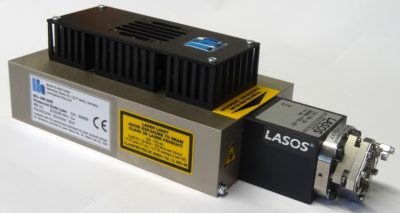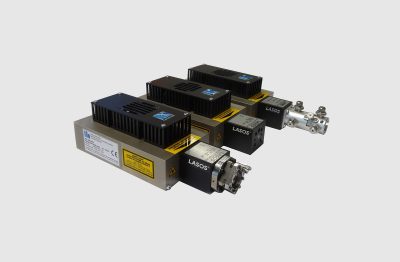
- Pulse Width Down to 40 ps
- Repetition Rate 20 MHz / 50 MHz / 80 MHz / CW (Switchable)
- External Trigger via Synchronisation Input
- Free Beam or Single-Mode Fiber Output
- Optical Power Up to 50 mW
- Fast ON / OFF / Multiplexing Capability
- All Electronics Integrated
- No External Driver Unit
- Simple +12 V Supply
- 160 x 90 x 60 mm3
Description
The BDL-SMN devices are combined picosecond / CW diode lasers. All the pulse driver and control circuitry is contained in the laser head. All that is needed to operate the lasers is a +12V power supply and a few control signals for setting repetition rate and optical power. Compared to their BDL-SMC predecessors, the BDL-SMN feature higher power and full intensity regulation both in the pulsed and in the CW mode.

In OEM applications the laser head can be embedded as it is, with the the external system providing the control signals. For stand-alone applications the LSB-C laser switch box or the LSB-C2 dual-laser switch boxes are available, see photos below.

Due to an internal power regulation loop, the BDL-SMN lasers feature extraodinarily stable optical power. Intensity drift by temperature changes and intensity noise by mode fluctuations in the laser diode are almost entirely suppressed. The lasers have a fast on/off function which can be used for beam blanking in scanning applications and for laser multiplexing.
The BDL-SMN lasers deliver a trigger output signal for synchronisation to bh TCSPC devices. The output amplitude is sufficient for distribution of the trigger signal to several TCSPC modules. The timing stability of the trigger pulses versus the optical pulses is better than 5 ps. Extended warm-up times are not needed. After switch-on of the power supply, the timing is stable after less than a minute warm up time. The BDL-SMN lasers can also be triggered externally. However, the trigger frequency should be in the range from 10 to 80 MHz in order to keep the intensity-regulation loop in the active range.
All BDL-SMN lasers are tansversal single-mode lasers. That means, the emission virtually comes from a single spot inside the laser. Consequently, the laser beam can be focused in a diffraction-limited spot or coupled into a single-mode fibre. Focusing and fibre injection is further improved by beam circularisation optics. The BDL-SMN lasers are available with fixed (pig tail) fibres, with Lasos Precision fibre connectors, and with Point-Source-Type couplers.
Specifications
|
|
BDL-SMN |
|
Optical |
|
|
Wavelength / nm |
375, 405, 445, 473, 488, 515, 640, 685, 785, Other on Request |
|
Repetition Rate |
20, 50, 80 MHz and CW Operation |
|
Pulse Width (FWHM, at Medium Power, at Maximum Power) 2) |
40 - 90 ps, 200 - 300 ps |
|
Peak Power |
40 to 500 mW |
|
Diameter of Laser Beam |
0.7 mm, TEM00 Mode |
|
Polarisation |
Horizontal |
|
Coupling Efficiency into Single-Mode Fiber (typ.) |
60% |
|
Satbility of Repetition Rate |
± 100 ppm |
|
Pulse-to-Pulse Jitter |
< 20 ps |
|
Reaction Time to 'Laser On' Signal |
3 µs |
|
Power and Pulse Shape Stabilisation after Switch-ON |
2 min 5) |
|
Trigger Output |
|
|
Pulse Amplitude |
-1 V (Peak) into 50 Ω |
|
Pulse Width |
1 ns |
|
Output Impedance |
50 Ω |
|
Connector |
SMA |
|
Delay from Trigger to Optical Pulse |
< 1 ns |
|
Jitter between Trigger and Optical Pulse |
< 10 ps |
|
Synchronisation Input |
|
|
Amplitude |
+3.3 V to +5 V into 50 Ω |
|
Duty Cycle |
10 to 30 %; DC Equivalent must be < 2.5 V |
|
Frequency |
20 to 80 MHz |
|
Switching from Internal Clock to Sync Input |
Automatic, by Average Voltage at Sync Input Connector |
|
Control Inputs |
|
|
Frequency (20, 50, 80 MHz) and CW Operation |
TTL / CMOS high 3) |
|
Laser ON / OFF |
TTL / CMOS low 3) |
|
External Power Control |
Analog Input, 0 to +10 V |
|
Power Supply |
|
|
Power Supply Voltage |
+9 V to +12 V |
|
Power Supply Current |
300 mA to 1.5 A 4) |
|
Power Adapter |
AC-DC Power Adapter, with Key Switch and Control Box in Cable |
|
Mechanical Data |
|
|
Dimensions (width x height x depth) |
(160 x 90 x 60) mm |
|
Mounting Thread |
two M6 Holes |
|
Maximum Values |
|
|
Power Supply Voltage |
0 V to +15 V |
|
Voltage at Digital Control Inputs |
-2 V to +7 V |
|
Voltage at Ext. Bias Input |
-12 V to +12 V |
|
Ambient Temperature |
15 °C to +35 °C |
(1) Typical values, sample tested. Depends on pulse width and selected power
(2) Depends on wavelength version
(3) All inputs have 10 kΩ pull-up resistors. Open input is equivalent to logic 'high'.
(4) Depends on ambient temperature. Cooling current changes due to temperature regulation of laser diode. (5) Operation below 15 °C may result in extended warm-up time.
Downloads
Documents
Applications
Application Notes
- Two-Photon Fluorescence Excitation by Picosecond Diode Lasers
- Recording the Kautsky Effect by Fluorescence Lifetime Detection
- Timing Stability of TCSPC Experiments
- Microsecond Decay FLIM: Combined Fluorescence and Phosphorescence Lifetime Imaging
- DCS-120 Confocal FLIM System with Wideband Beamsplitter
- An AFM/NSOM System with Fluorescence Lifetime Imaging
- NSOM FLIM with the Nanonics AFM/NSOM System
- Implantable Fibre-Optical Fluorescence-Lifetime Detection System for in-vivo Applications
- TCSPC Fibre-Probe System with an Exchangeable Tip
- TCSPC System Records FLIM of a Rotating Object
- Metabolic Imaging with the DCS-120 Confocal FLIM System: Simultaneous FLIM of NAD(P)H and FAD



